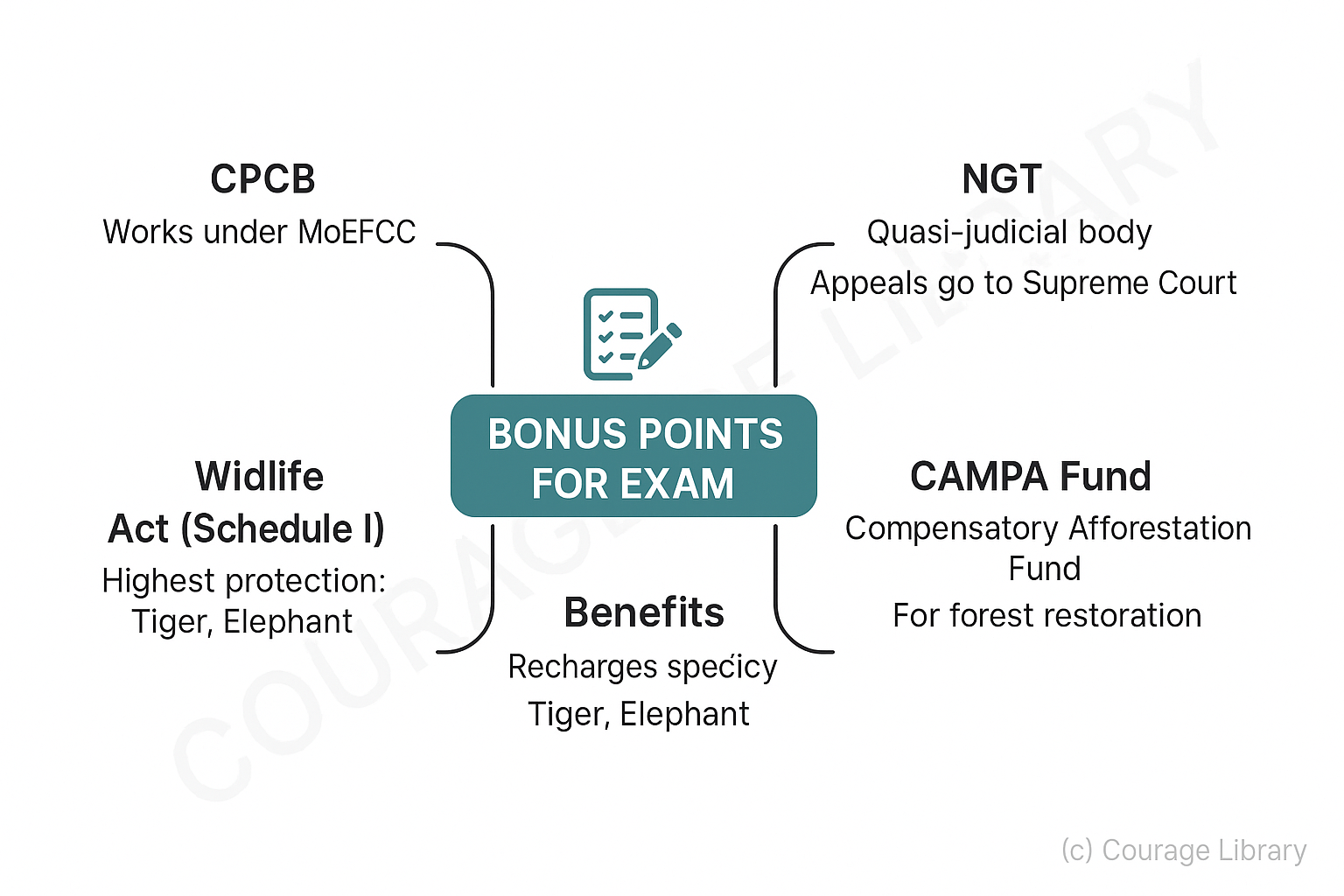SSC CGL - Detailed Guide 2025
Self-Paced Course

Environmental Protection Acts & Policies (India)
Reference: Lucent GK, NCERT Class 6–12
Environment (Protection) Act, 1986
Enacted: After the Bhopal Gas Tragedy (1984)
Purpose: Umbrella legislation for protection & improvement of the environment.
| Key Features |
|---|
| Gives Central Government wide powers to take action |
| Covers air, water, soil, and noise pollution |
| Authorizes setting of environmental standards |
| Enables closure of polluting industries |
Basis for: EIA (Environmental Impact Assessment), Coastal Regulation Zones (CRZs), Hazardous Waste Rules, etc.
Air (Prevention & Control of Pollution) Act, 1981
Objective: To prevent, control, and reduce air pollution.
| Key Provisions |
|---|
| Establishes Central and State Pollution Control Boards (CPCB & SPCBs) |
| Defines air pollutants and emission standards |
| Empowers boards to issue directions and close non-compliant industries |
| Allows for the declaration of Air Pollution Control Areas |
Works closely with the Environment Protection Act for enforcement.
Water (Prevention & Control of Pollution) Act, 1974
Objective: To maintain or restore the wholesomeness of water.
| Key Points |
|---|
| First major environmental law in independent India |
| Establishes CPCB & SPCBs |
| Controls discharge of pollutants into water bodies |
| Requires prior consent for discharge of effluents |
Focused on rivers, lakes, groundwater, and industrial discharge control.
Forest (Conservation) Act, 1980
Aim: To prevent deforestation and conserve forest ecosystems.
| Highlights |
|---|
| Restricts conversion of forest land for non-forest purposes without Central Government approval |
| Includes provision for compensatory afforestation |
| Used to protect tribal and ecological rights |
Very relevant for project clearances like highways, dams, etc.
Wildlife (Protection) Act, 1972 (Amended 2022)
Purpose: To protect wild animals, birds, and plants.
| Key Provisions |
|---|
| Establishes protected areas (National Parks, Sanctuaries, Conservation Reserves) |
| Lists species under Schedules I–VI (Schedule I = most protected) |
| Prohibits hunting and trade in endangered species |
| 2022 Amendment: Adds protection for plant species; aligns with CITES; more power to states |
Basis for Project Tiger (1973), Project Elephant (1992)
Biological Diversity Act, 2002
Objective: To conserve biodiversity and ensure equitable sharing of benefits from its use.
| Key Features |
|---|
| Implements CBD (Convention on Biological Diversity, 1992) |
| Establishes National Biodiversity Authority (NBA) |
| Ensures access and benefit-sharing (ABS) for biological resources |
| Recognizes community rights over traditional knowledge |
India has rich traditional knowledge systems (e.g., Ayurveda, tribal medicine).
National Green Tribunal (NGT), 2010
Objective: To provide speedy and specialized environmental justice.
| Structure | Details |
|---|---|
| Established under | National Green Tribunal Act, 2010 |
| Headquarters | New Delhi |
| Jurisdiction | Environmental protection and conservation matters |
| Composition | Chairperson (judicial) + experts + technical members |
NGT decisions are binding and have significantly improved environmental governance.
Quick Revision Table
| Act/Institution | Year | Focus Area |
|---|---|---|
| Environment (Protection) Act | 1986 | Umbrella law; pollution control |
| Air Act | 1981 | Air quality and emission norms |
| Water Act | 1974 | Water pollution & treatment |
| Forest Conservation Act | 1980 | No deforestation without approval |
| Wildlife Protection Act | 1972/2022 | Species and habitat protection |
| Biological Diversity Act | 2002 | Conservation and benefit-sharing |
| National Green Tribunal (NGT) | 2010 | Environmental dispute resolution |
Bonus Points for Exam:
- CPCB works under Ministry of Environment, Forest & Climate Change (MoEFCC)
- Schedule I of Wildlife Act = Highest protection (e.g., Tiger, Elephant)
- NGT is a quasi-judicial body; appeals go to Supreme Court
- CAMPA Fund: Compensatory Afforestation Fund for forest restoration

Start Your SSC CGL Journey Now!
Join Courage Library to experience disciplined study and expert support.
Be a Couragian!